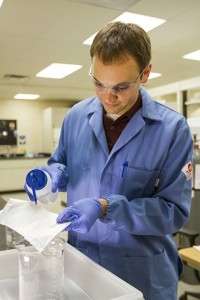Poison dart frog inspires new way to de-ice planes

Curiosity about the way a particular tropical frog releases a toxic substance through its skin to protect itself led Arizona State University engineer Konrad Rykaczewski to an idea for a new anti-icing technique for aircraft.
Rykaczewski and three ASU graduate students working with him devised a method that would add a coating to aircraft surfaces that secretes antifreeze to prevent ice formation.
The method employs a skin-like bi-layer coating. The inner layer stores antifreeze liquid and the outer porous superhydrophobic layer repels cold rain that could become ice.
When the outer layer fails, for example because of condensate or frost accumulation, the inner layer releases antifreeze to prevent ice sheet formation. As a result, the bi-layer "skin" can delay freezing rain accumulation 60 times longer than a superhydrophobic coating alone.
Rykaczewski is an assistant professor of aerospace and mechanical engineering in the School for Engineering of Matter, Transport and Energy, one of ASU's Ira A. Fulton Schools of Engineering.
Experiments on his new ice-resistance system showed it significantly delayed the time it took ice to form under freezing conditions.
Since publication of a paper on his de-icing method in a research journal, the idea has gained the attention of professional colleagues and news media.
Other experts studying de-icing methods are saying Rykaczewski's work is innovative and shows definitive promise to provide more effective prevention of ice buildup.
More information: Sun X., Damle V. G., Liu S., Rykaczewski K. (2015). Bioinspired Stimuli-Responsive and Antifreeze-Secreting Anti-Icing Coatings. Adv. Mater. Interfaces, 2: . DOI: 10.1002/admi.201400479
Provided by Arizona State University


















